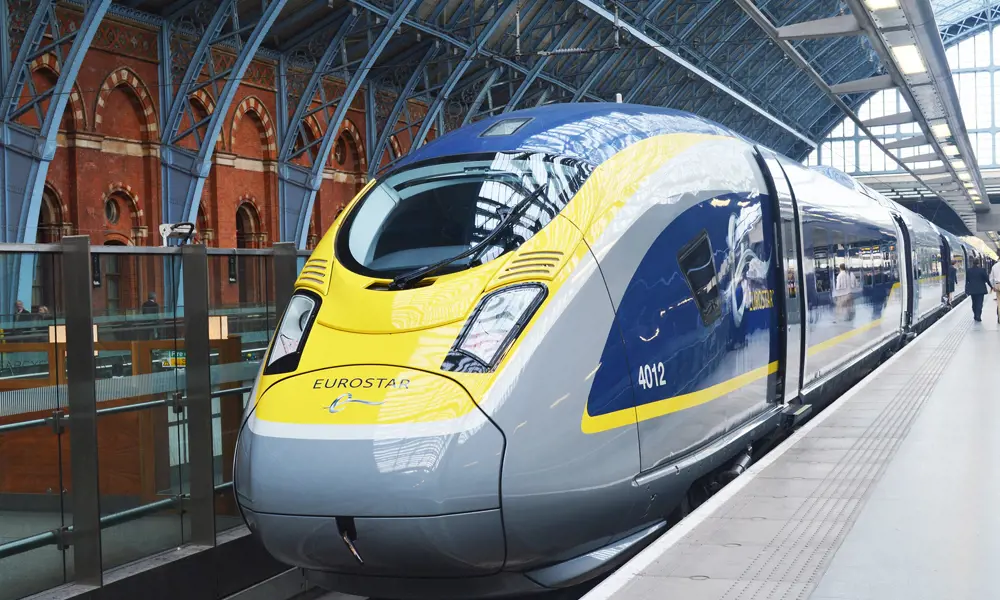
High speed evolution
Eurostar has been operating high speed trains between London, Paris and Brussels via the Channel Tunnel since 1994, using a fleet of Alstom-built trains derived from the French TGV system. Fifteen years on, these trans manche super trains (TMST), consisting of 18 carriages plus two power cars, needed overhaul. Eurostar decided to add new trains to its fleet which were able to operate on the existing routes but with the potential to reach further afield, via the now expanded European high speed line network, to Amsterdam, Geneva and German cities.
In 2010, Siemens won the €700 million Eurostar order with a new 320 km/h (200 mph) version of its Velaro high speed train. The company has a long history of rail innovation: it created the world’s first electric powered train in 1879, and has been involved in high speed rail development since the 1960s.
The first tranche of 10 trains has now been built and is being tested in France, Belgium, the UK and the Channel Tunnel. The new Velaros will start carrying Eurostar passengers towards the end of the year.
Developing velaro
By 2010, Siemens had gained decades of experience building high speed trains, initially for Germany and then further afield. At the turn of the millennium, the company had designed and manufactured a train concept for Deutsche Bahn named the ICE3, which was the first high speed train in Europe to dispense with locomotive power cars and to distribute all the traction equipment along the length of the train.
The traction equipment is distributed across several coaches. Each traction unit comprises three coaches with one carrying the high-voltage equipment consisting of pantographs and main circuit breaker. The transformer and the other two other coaches carry the traction invertors and the traction motors, which are located in the bogies. The traction rating of this three-coach-unit is more than 4 MW.
it became the ‘Velaro’, derived from the Spanish words for high speed, velocitad alto
The company then sought to develop the concept further by defining the performance criteria, such as maximum speed and power consumption that high speed rail operators around the world were likely to seek. From these potential markets, a mix of technical and geographic factors on a basic design ‘platform’ was determined and named – it became the ‘Velaro’, derived from the Spanish words for high speed, velocitad alto.
Among these requirements was the need to be able to operate in a wide range of temperatures, ranging from +50° C in the deserts of Spain to -50° C in the Russian winter. While the basic parameters of the Velaro platform design are now set, there is scope for variation so that the trains supplied to China and Russia in 2008/09, for example, are 30cm wider standard. All the vehicles are made from aluminium, although the way the body shells are finished reflects their intended use – so, to cope with the country’s severe weather conditions, those made for Russian Railways are fitted with more insulation than those for Western Europe.
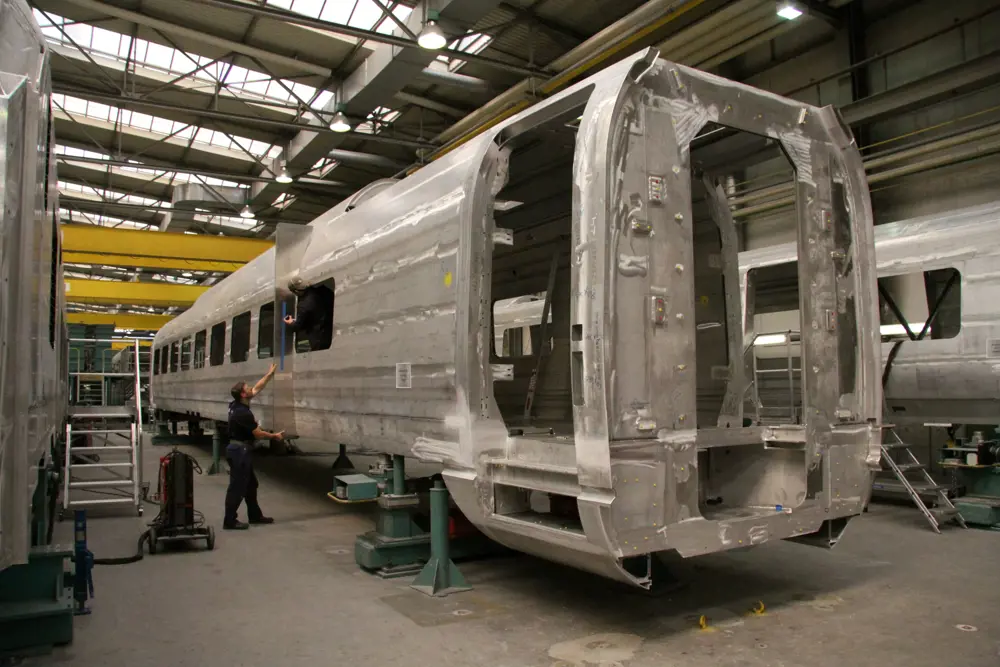
Velaro aluminium car body construction at Siemena in Krefeld, Germany © K Fender
Technological evolution
Historically, heavy components such as main transformers had dictated the need for power cars at either end of a train, resulting in less space for passenger accommodation. By mounting major components underfloor, or on the roof, distributed along the length of the unit, an extra 20% of usable space has been gained in the passenger cars. The seating capacity has risen from nearly 750 to almost 900 people in the new Eurostar trains, compared to the previous TMST trains for the same length of unit.
As electronics technology has advanced, so have high speed rail traction invertors. The first Velaro for Spain a decade ago used GTO (Gate Turn Off) thyristor invertors but as power device technology has advanced, the more recent trains built for Russia, China and now Eurostar have used insulated-gate bipolar transistor (IGBT) invertors.
These IGBT invertors are improvements on GTOs, thanks to advances in the field of semiconductors. They need less additional equipment for switching from AC to DC and vice versa. They are consequently smaller and lighter at the same rating.
As electronics technology has advanced, so have high speed rail traction invertors
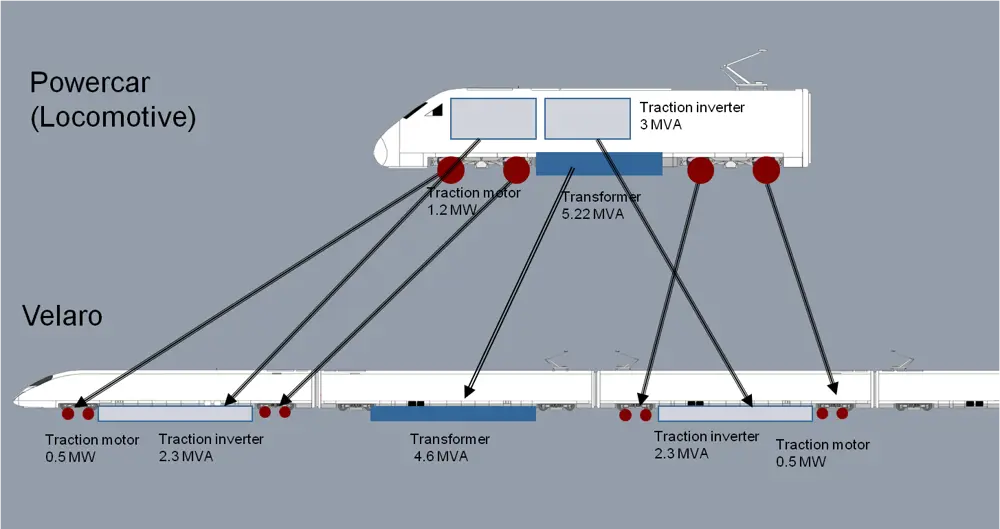
From power car to distributed power: equipment that was located in one power car on the old Eurostar is now distributed along the underfloor area of the train © Siemens
In the Eurostar Velaro, which is made up of 16 coaches and just under 399m long, there are four identical, independent traction units, with eight traction invertors. The potential failure of one invertor does not affect the remaining units or the train’s built-in system redundancy to continue to operate at full speed. Because equipment is distributed along the train, the weight is more uniformly distributed over the entire length, meaning the individual wheel sets bear less weight. This, in turn, reduces wheel and track wear and bogie maintenance while ensuring peak maximum efficiency; 50% of all axles are powered and fitted with traction motors. This enables the train to cope with the steep gradients found on modern high speed lines (and into and out of the Channel Tunnel). One further benefit of the distributed traction principle is the lower necessary adhesion factor, which enhances electric (regenerative) braking under poor rail conditions.
The basic design architecture of the Velaro Eurostar is for two eight-coach units coupled together as an effective mirror image of each other – two eight‑car trains, together with only a driving cab at one end, which includes everything onboard with all the traction and safety systems replicated along the train. This builds in useful redundancy in the event of some equipment failing or being damaged – the train can then operate at reduced power and speed with far less energy than with all eight of its traction invertors working.
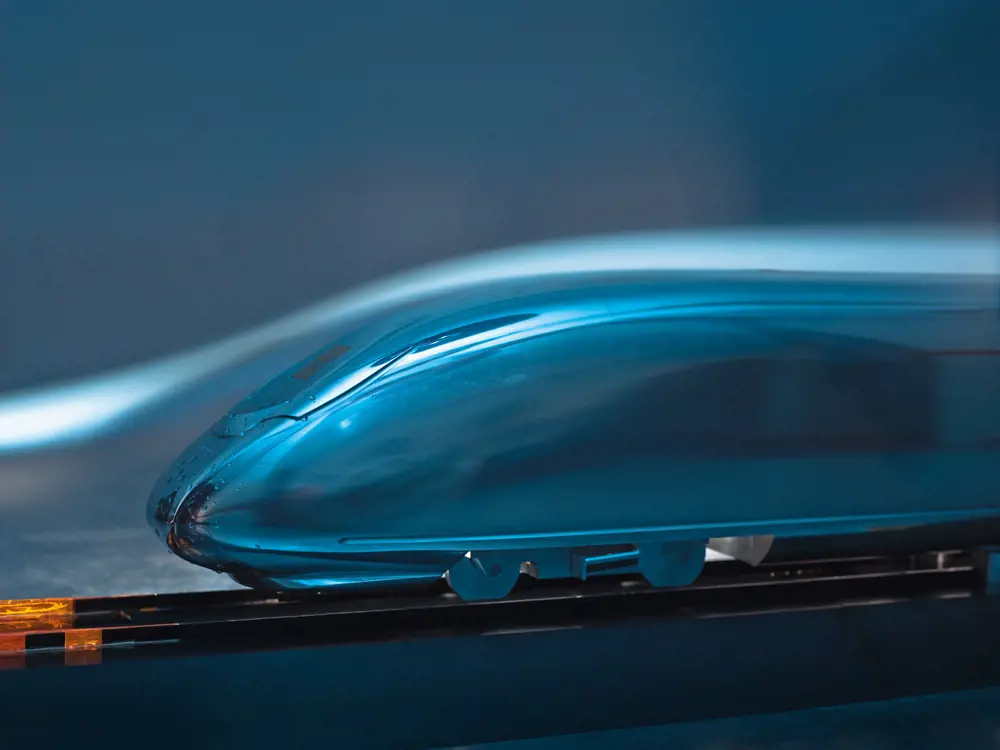
Testing of the aerodynamic behaviour of the Velaro Eurostar in a wind tunnel test. The revision of the aerodynamic concept has led to a reduction in equivalent air resistance surface of approximately 20% compared to earlier designs of Velaro units © Siemens
Aerodynamic efficiencies
A separate working group was set up for improving the aerodynamic elements of the Eurostar. Based on the modelling of previous Velaro train sets and subsequent simulations, various constructive alternative options were developed and tested using simulation technology, then developed further and simulated again. These new aerodynamic design features were then tested in wind tunnel experiments. In order to validate these measures, elements such as the cladding of the intercar gangways was constructed, mounted on a Velaro, tested and subjected to measurements.
The train is now quieter, thanks to the raised section of the roof. The elevated roof also means there is less ‘tunnel boom’ caused by the compression and displacement of air when the train speeds through tunnels and emerges from the restricted tunnel bore back to the open environment. Roof-mounted equipment such as pantographs and air-conditioning units is integrated, thereby decreasing the energy demand. The spoiler, nose and front sections have also been aerodynamically optimised, and in so doing reduce air turbulence, particularly at track level where there is potential to disturb track ballast and cause stone lift.
A separate working group was set up for improving the aerodynamic elements of the Eurostar
Compared to earlier Velaro train sets, the bogie areas are now noticeably smaller and the design of the under-floor area has been optimised. This included redesigning the exhaust openings of the coolers in the traction system, improving the transition zones to and from the bogie, and the bogie skirts themselves.
The braking system is also energy-efficient. Since the first generation, the Velaro’s electric regenerative brake has been feeding surplus braking energy back into the power grid. The result is 10% energy savings and a reduction in mechanical wear. At the moment, this system is only usable on the European continent, as the UK section of high speed line (HS1) is not currently equipped to receive regenerated power back into the supply network.
Interior fittings
The Eurostar Velaro is the largest‑capacity European high speed train, with almost 900 seats for passengers per journey. Each train has 26 toilets – most arranged back to back so they can share plumbing and roof-mounted water tanks. Each train is equipped with automated wheelchair ramps, which can open to either side of the train. The train’s interior was entirely customised by Eurostar, with interior furnishings taken up by Italian car designer and coachbuilder Pininfarina.
The train’s power supply system has redundancy installed throughout the train to ensure a constant supply of power for air‑conditioning, ventilation, and heating, as well as powering fans, pumps, catering equipment and lighting. Siemens has learned from experience with earlier models that onboard auxiliary systems need to have their own separate power invertor. This is independent of power supply changes, as the train moves through neutral sections on high speed lines (required every 50km on 25KV AC 50 Hz systems – or every eight to twelve minutes when travelling at maximum speed of 320km/h). The train control system is replicated to build in redundancy; one set of armoured cables is under the train floor, the other on the roof so that if one becomes damaged in service the other can replace it.
The design of the interiors is modular, allowing the operator to choose the basis of interior layout. There are fixed areas such as bulkheads and equipment installations, but the design allows flexibility in the location of interior features.
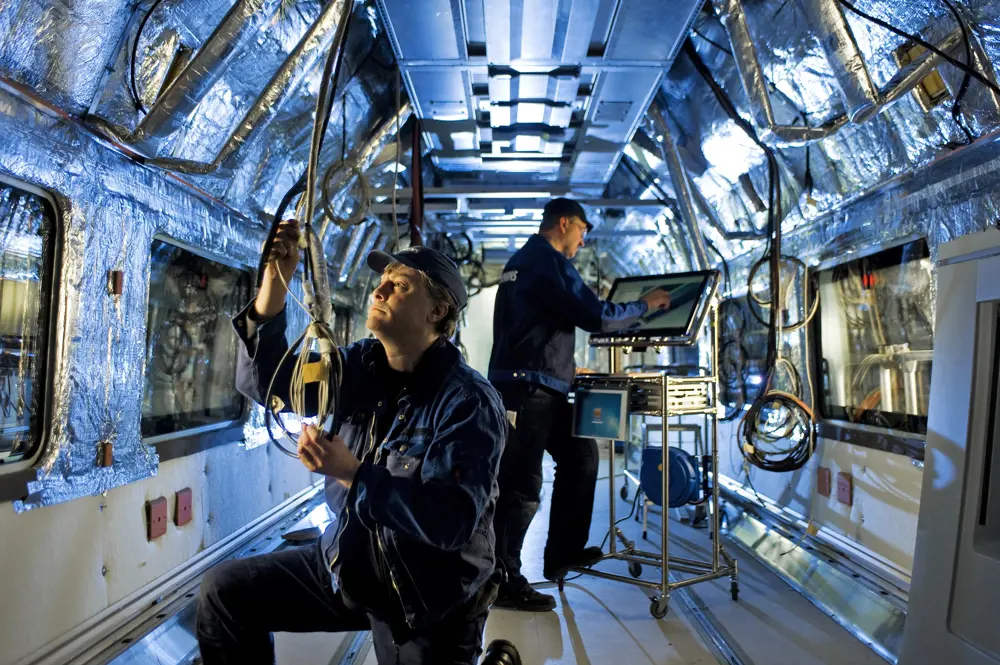
The Velaro undergoing tests during the final assembly process at Siemens in Krefeld, Germany © Eurostar
Crossing borders
Europe’s railway system has developed over 175 years, and the safety and signalling systems used in each country have, until very recently, been national in character and generally incompatible with those in neighbouring countries. Even high speed lines have different versions of modern ‘cab signalling’, where the train driver receives instructions and information via screens in the cab rather than the traditional signals mounted on posts beside the tracks (at 300 km/h these would be almost impossible to correctly identify by the driver).
Eurostar is planning a direct service to Amsterdam. The trains running from London to Amsterdam will pass from 25kV 50 Hz AC to 3kV DC in Brussels and Antwerp, then back to 25kV 50 Hz AC on the route to Rotterdam and Schiphol before entering Amsterdam, operating from 1.5kV DC. Each different traction voltage necessitates a pair of pantographs on the train, plus traction equipment capable of handling multiple vacancies.
Automatic Train Protection signalling systems pose even more of an engineering challenge with no less than nine system variants in use between London and Amsterdam; the train needs to be able to seamlessly switch from one to another while moving, often at over 160km/h. The integration of nine different safety systems provided by three different suppliers has been one of the biggest challenges in successfully introducing the Velaro.
Maintaining the new trains
🚆 The purpose-built maintenance depot for the Eurostar
Eurostar’s high-security train maintenance depot at Temple Mills in East London was purpose-built for the Class 373 fleet when Eurostar started operating from London St Pancras International station via the completed HS1 high speed rail line in 2007. To accommodate the Class 374, some major changes have been made which reflect how the design of high speed trains has evolved. The vehicles of the new Velaro are built to the European standards for high speed trains and are wider and taller.
Unlike the Class 373, the Velaro has equipment spread along the train both under the coaches and in the roof space – as a result, the depot has required some extensive work to add roof height platforms the entire length of the train on several of the covered maintenance tracks; the power supply inside the depot has had to be reconfigured. Previously, a short 30m retractable supply above the power cars sufficed for testing, whereas the new train needs power along its full length as it has multiple pantographs for power pick up that will need testing. The power supply inside the depot uses aluminium conductor rail rather than copper wire as used on most of the high speed network.
A host of smaller modifications has also been made to the depot to accommodate the external doors and wheel sets being in different places on the new trains. The positioning of the wheels has been critical to enable static testing of the cab signalling system for both types of train in the fleet on the same track (as the system works by detecting the train’s wheels). The alternative – having to dedicate one set of tracks to each type of train would have wasted space and delayed maintenance work.
Major overhauls where all the big components such as traction motors, traction invertors and safety systems are removed and replaced with new or overhauled components will be undertaken every 1.6 million km – each train is expected to operate around 450,000km a year so each train will be inspected on average at least once a week and undergo a full overhaul every 3-4 years.
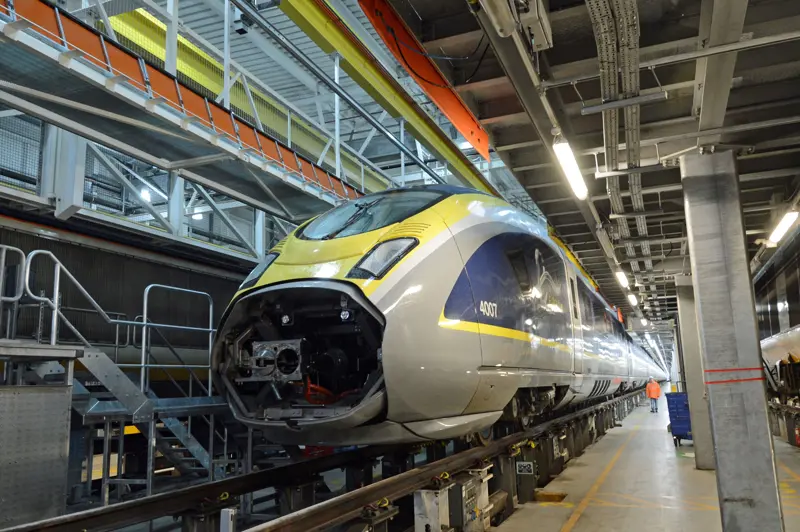
Eurostar
Down the line
The first 10 Velaro Class 374 trains will operate alongside the existing previous generation of TGV derived Class 373 TMSTs.
The future maintenance for the new fleet will be shared by Siemens and the existing Eurostar maintenance employees; Siemens will provide technical support and spares supply (a parts catalogue of nearly 7,000 items has been prepared) and diagnostic data while Eurostar will undertake the actual maintenance. All the Class 374 trains will be based in the UK and all major work will be undertaken at Temple Mills, although daily servicing and repairs can be undertaken in both Paris and Brussels – see Maintaining the new trains.
Eurostar will start using the new e320 train sets in November 2015. The full fleet of 17 trains will be progressively introduced in 2016 with all in service by 2017. The new London to Amsterdam route due to start in 2016/17 is expected to have a journey time of around four hours.
***
This article has been adapted from "High speed evolution", which originally appeared in the print edition of Ingenia 64 (September 2015).
Contributors
Keith Fender
Author
Martin Steuger is Siemens’ project director for its Velaro trains, joined Siemens in the early 1990s, and initially worked on electric locomotives and regional trains. In 2000, he became the project manager for the 330km/h ICE3 and led the process of gaining approval for this German‑built train to be used in France and Belgium on brand new high speed lines in both countries.
Nigel Broughton is Siemens UK project manager for Velaro e320 train implementation. From Virgin Trains, as project manager for Class 220/221 Voyager new train induction, he joined Siemens in 2002 and initially worked on delivery projects for the Desiro UK fleet for the UK West Coast Main Line.
Keep up-to-date with Ingenia for free
SubscribeRelated content
Electricals & electronics
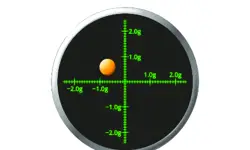
Accelerometers
Used in earthquake measurements, laptops, planes and even in stargazing apps, today’s accelerometers are much smaller than when they were first developed in 1927. Find out how they detect movement and vibration.

How to maximise loudspeaker quality
Ingenia asked Dr Jack Oclee-Brown, Head of Acoustics at KEF Audio, to outline the considerations that audio engineers need to make when developing high-quality speakers.
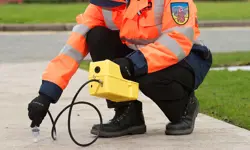
Cable fault locator
The winner of the Institute of Engineering and Technology’s 2014 Innovation Award was EA Technology’s CableSnifferTM, which uses a probe and chemical sensing technology to identify faults, saving energy companies millions of pounds each year.
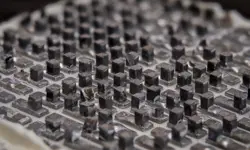
Peltier devices
First discovered by Jean Charles Peltier, the Peltier effect is used across a range of devices, from thermoelectric heaters and coolers to sensors and spacecraft. Find out how the use of semiconductor materials can act to manage heat transfer.
Other content from Ingenia
Quick read

- Environment & sustainability
- Opinion
A young engineer’s perspective on the good, the bad and the ugly of COP27

- Environment & sustainability
- Issue 95
How do we pay for net zero technologies?
Quick read

- Transport
- Mechanical
- How I got here
Electrifying trains and STEMAZING outreach

- Civil & structural
- Environment & sustainability
- Issue 95